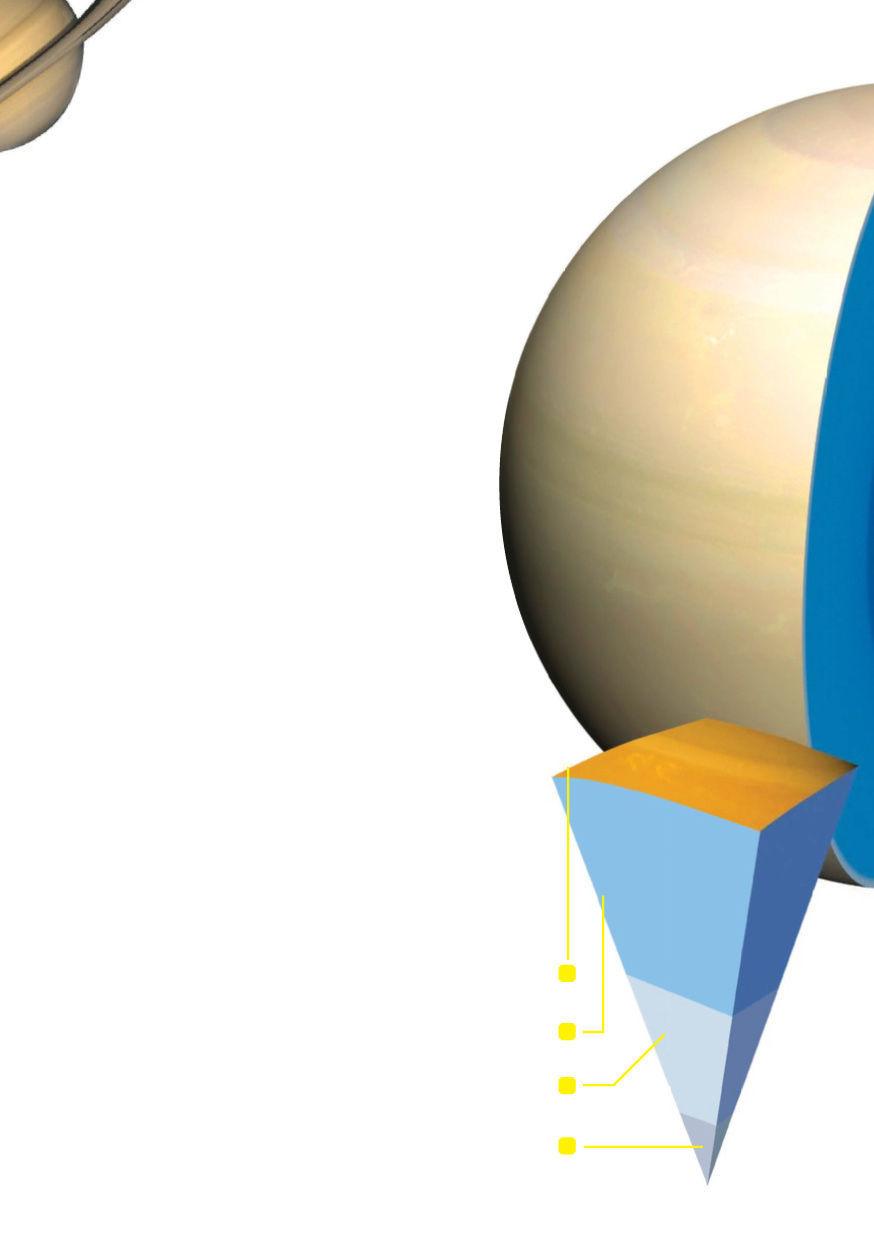
12 minute read
Saturn
from Oldie
by maurice.2008
Saturn is often compared with Jupiter, but it can hold its own Saturn inside and out
Saturn is a gas giant as it has no solid surface and is mostly composed of gas. But it does have a rocky core, which is similar in composition to the Earth’s. Comprising iron, nickel and silicate rock, it is estimated to be between 10 and 20 times the size of the Earth’s core. Surrounding the core, there’s a layer of ice made of ammonia and other elements, then a layer of highly pressurised metallic hydrogen, and finally molecular hydrogen that changes from a liquid to a gas. The outer layers of the planet are different types of ice, including ammonia, ammonium hydrosulphide and water. The cloud cover is coloured yellow by ammonia. Density, pressure and temperature all increase as you pass through the atmosphere and into the core, resulting in a very hot interior at about 11,700°C (21,000°F). Saturn sends out more than twice the energy it receives from the Sun. Some of this is due to gravitational compression, but we aren’t sure if that can account for such a huge energy output. One possibility is an interaction between helium and hydrogen in the atmosphere, which may put out heat in the form of friction.
Advertisement
Saturn has a magnetic field 578 times stronger than Earth’s. Scientists believe that the metallic hydrogen layer generates an electric current that is responsible for the magnetic field, called a metallic-hydrogen dynamo. The magnetic field is a dipole, with north and south poles. Aside from the rings, one of the most interesting features of Saturn is its auroras. These beautiful light displays have been captured at both the north and south pole regions by the Hubble Space Telescope and the Cassini probe, and appear as circles of light around each pole.
Molecular hydrogen
Liquid metallic hydrogen
Ice
Rocky core The core is likely primarily iron and, although small, very dense
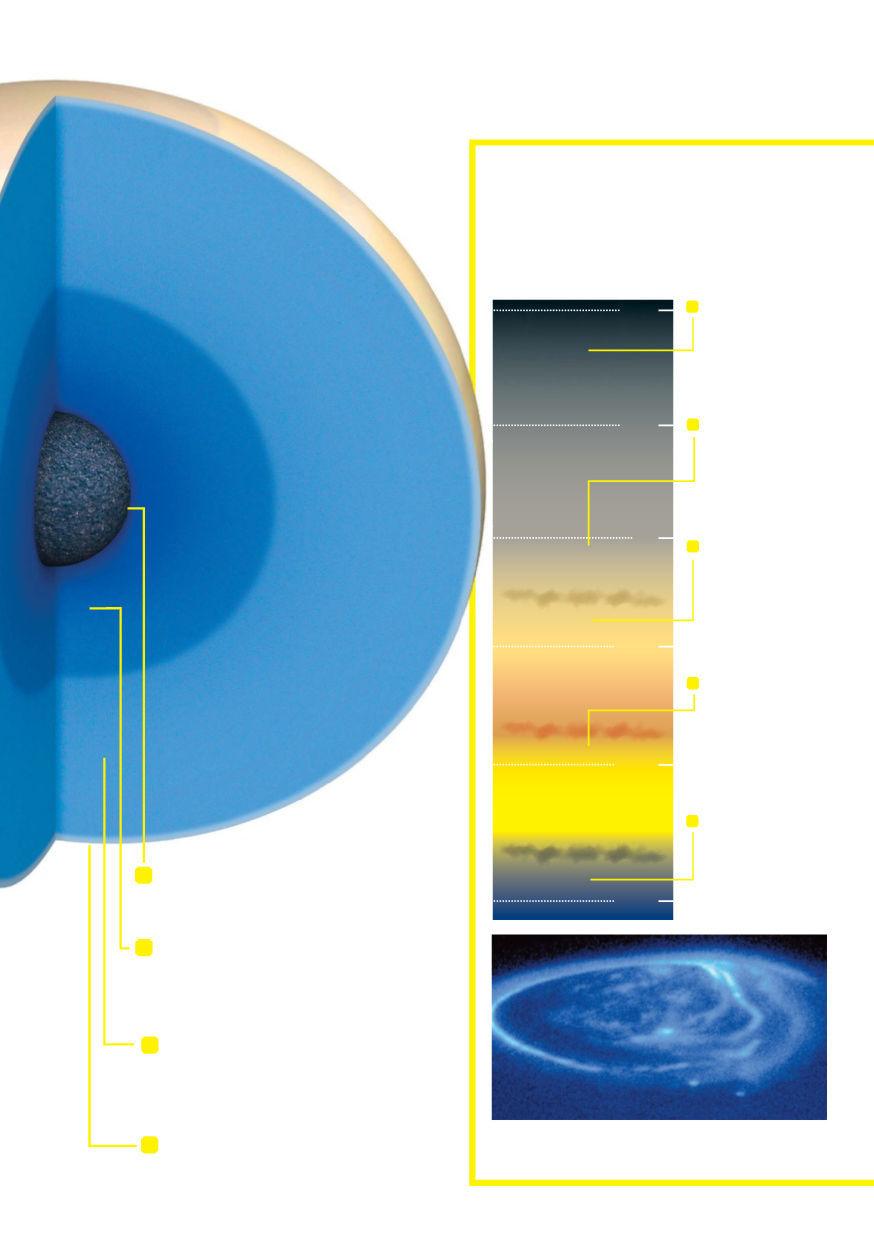
Ice This isn’t water ice as we know it, but a mixture of ammonia, methane, hydrogen and water
Liquid metallic hydrogen The hydrogen at this depth is under such high pressure that it transforms to a metallic state
The atmosphere of a gas giant
200km
Stratosphere This upper level is warmed by the Sun. The temperature here varies depending on the weather below
100km
Troposphere 0km
-100km
-200km
-300km
Troposphere The outer atmosphere comprises about 96.3% hydrogen and 3.25% helium, with additional traces of other elements
Ammonia ice Pure ammonia ice clouds sit under the troposphere, which is at 0.5 to 2 bars of pressure and -173°C to -113°C (-280°F to -171°F)
Ammonium hydrosulphide With a pressure of 3 to 6 bars and temperatures of 17°C to -38°C (62°F to -37°F), the ice clouds are ammonium hydrosulphide
Water ice Temperatures in this level drop all the way to -88°C to -3°C (-124°F to 26°F) and the pressure is greatest at 10 to 20 bars
Saturn’s atmosphere has some similarities to Jupiter’s In the clouds
The pressure in Saturn's layered clouds increases and temperatures drop as you travel further down towards the planet’s core. At the upper layer, the clouds are made up of ammonia ice, followed by water ice clouds with a layer of ammonium hydrosulphide ice, and the bottom layer is ammonia mixed in water droplets.
Saturn has bands of clouds that are divided into zones and belts. The zones are the lightercoloured areas and the bands are darker, with the orange and reddish hues coming from sulphuric compounds. The bands of clouds are named in the same way that Jupiter’s are labelled, according to their locations in the northern or southern hemisphere of the planet. Saturn’s cloud bands are very faint and more difficult to distinguish from each other than Jupiter’s. We weren’t able to clearly see the
Global picture of a gas giant
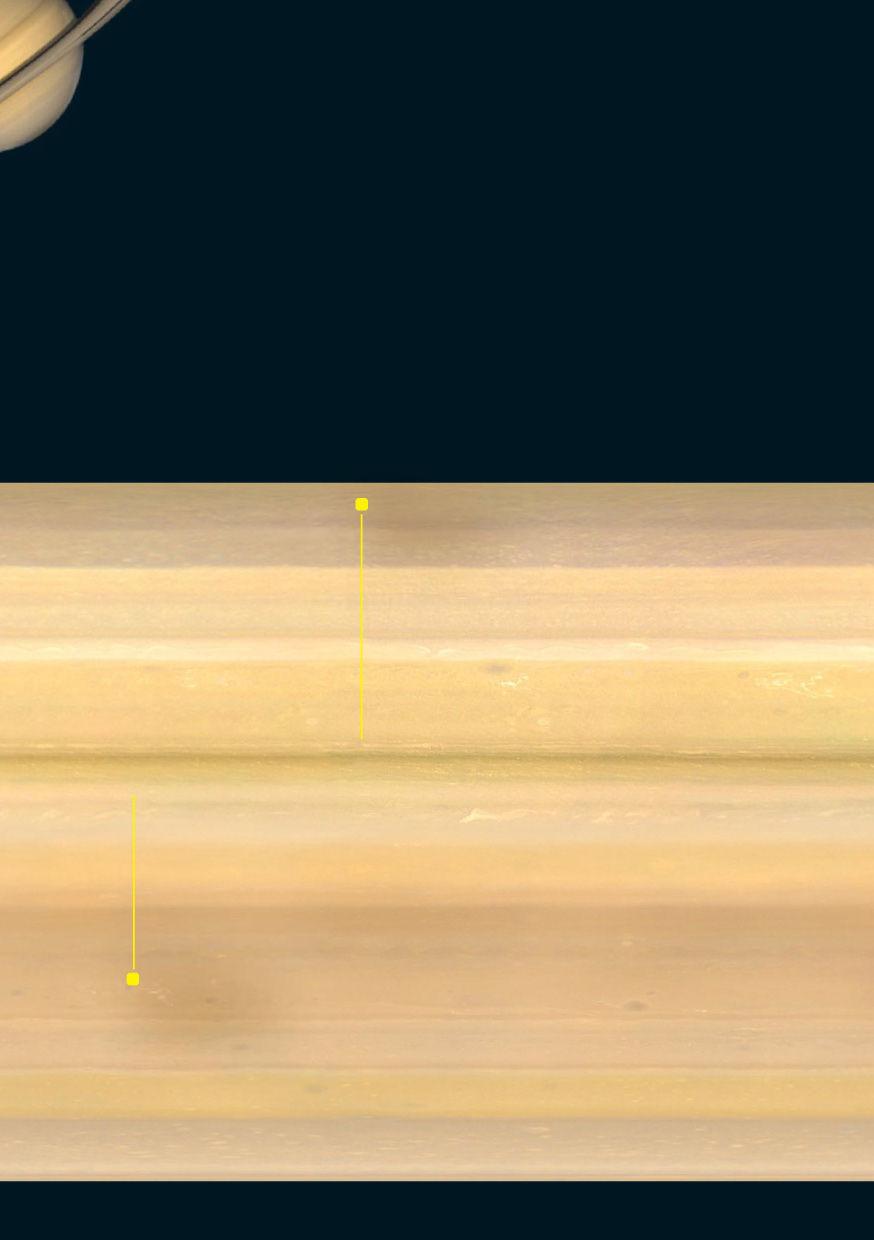
Rings The rings disappear into a thin line when Saturn is viewed straight-on
Equatorial Zone The view of this zone on Saturn is bisected by its ring system, and the zone is wider than on Jupiter
distinctions between the fainter bands until the Voyager probes flew by Saturn in the Eighties.
Like Jupiter, Saturn has wind jets that alternate westwards and eastwards out from the equator. But Saturnian winds are fast, reaching maximum speeds of around 1,800 km/h (1,120 mph), they are the second fastest winds among the Solar System’s planets after Neptune’s.
Saturn's north polar vortex has a unique hexagon-shaped cloud pattern, with straight sides estimated to be about 13,800 km (8,600 mi) long, which appears to rotate at the same speed as the interior of the planet. The south pole is much warmer than the rest of the planet; it's believed to be the warmest spot on Saturn.
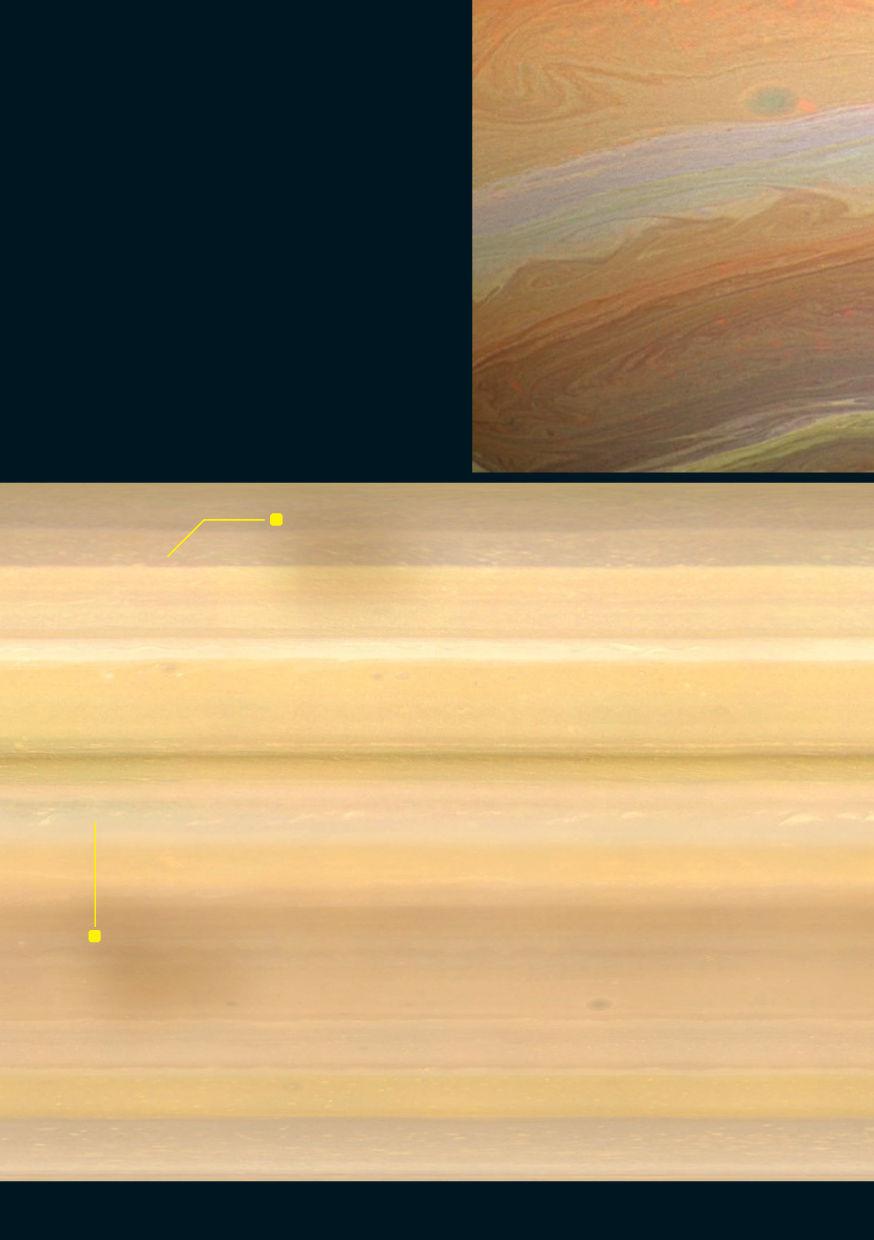
Northernmost Temperate Belt This belt is wavy due to an unusual, hexagonal-shaped polar vortex located at Saturn’s north pole
This infrared image from Cassini shows a close-up of the swirling clouds on Saturn’s banded planetary surface
Storm Although much milder than Jupiter, Saturn still has white spots occasionally, indicating storms occurring in the clouds
The ring system
Saturn's crown jewel
Although Saturn isn’t the only planet in our Solar System with rings, it’s the only one with a system this big. There are billions of tiny particles, mostly ice but with some rocky material, too. Despite the fact that they increase Saturn’s brightness, we weren’t even aware of its rings until Galileo observed them via telescope. He was confused a few years later when the rings seemed to disappear, not knowing that they just weren’t visible with his telescope when Earth is on the same plane as Saturn. By the 1800s we knew that the rings were just that – not moons, not a single disc, but many rings comprising tiny particles.
Saturn’s ring system is divided into rings, arcs, divisions and gaps. The first seven rings to be discovered were designated with letters of the alphabet A through G, but they were named in order of discovery so from innermost to outermost ring they are D, C, B, A, F, G and E. Three other named rings have been discovered since Ring G, but these are named after the moons that orbit with them: Janus, Epimetheus, Pallene and Phoebe. In addition to the rings, there are two ring arcs, incomplete trails of dust ejected by the moons Methone and Anthe kept in arc formation via resonance with two other gaps. There are also two divisions – the Cassini Division, between Rings A and B, and the Roche Division, a space between Rings A and F.
A Ring
B Ring

C Ring
D Ring C Ring
Colombo Gap This gap, in the inner C Ring, contains a ringlet of its own called the Titan Ringlet (named because it is in orbital resonance with the moon Titan)
B Ring
Maxwell Gap Situated within the outer C Ring, the Maxwell Gap also has a ringlet, but it’s not circular and contains wavy structures
Huygens Gap
Found at the inner edge of the Cassini Division, this gap contains a dense ringlet with an unusual structure caused by resonance with the moon Mimas
Cassini Division Located between the A and B rings, this apparent gap in reality actually contains darker-coloured ring material
D Ring
E Ring
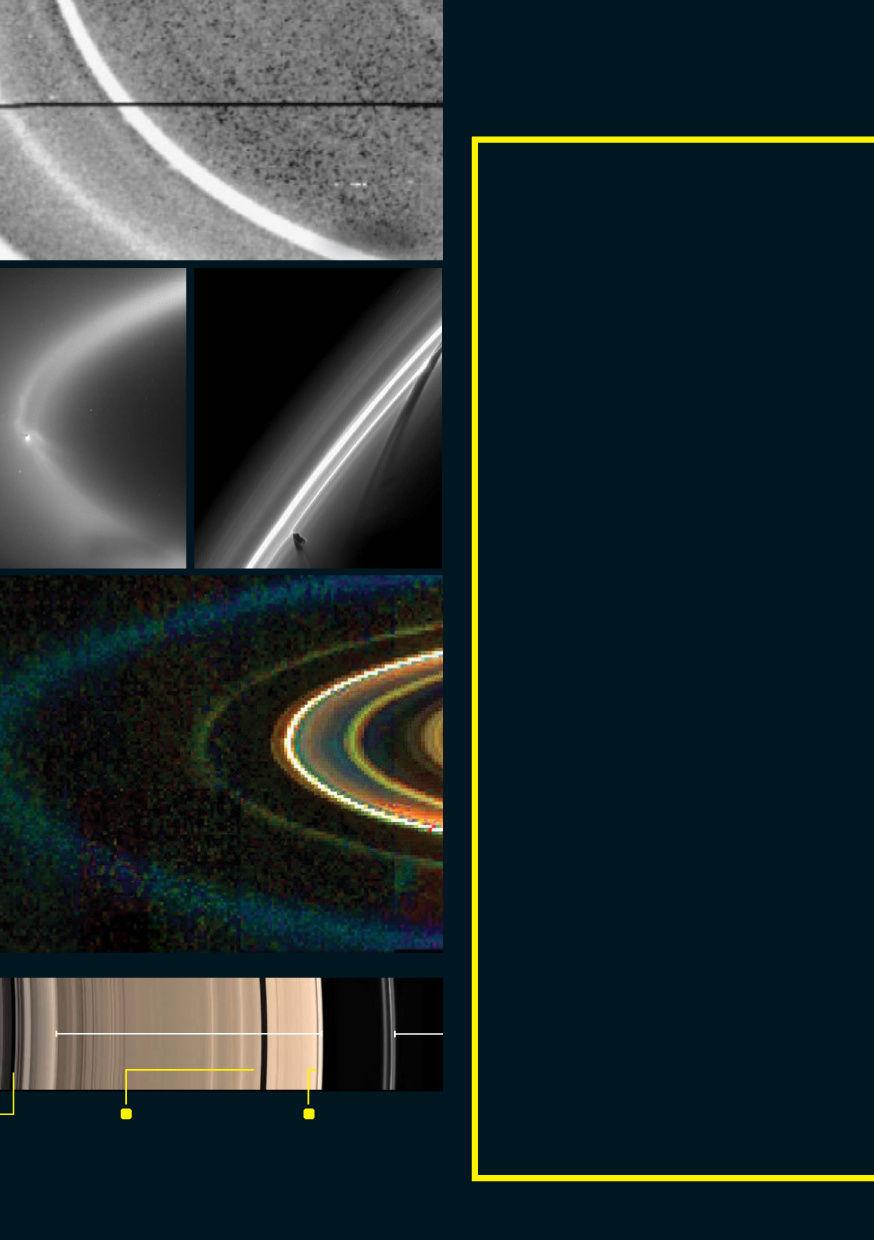
F Ring
G Ring
A Ring F Ring
Encke Gap This gap is located within the A Ring, and its existence is due to the moon Pan orbiting inside. Encke also contains small ringlets and has spiral density waves
Keeler Gap The moon Daphnis is responsible for this gap located in the A Ring. Daphnis also creates waves around the gap’s edges
Saturn in numbers Fantastic figures and surprising statistics about the ringed planet
578 times Saturn’s magnetic field is 578 times more powerful than Earth’s
Saturn and Jupiter together comprise about 92 per cent of the planetary mass of the Solar System 92%
14 years Saturn’s rings seem to disappear about every 14 years or so due to the fact they’re so thin and we see them edge-on
80.00kg A person weighing 80.00kg (176.37lb) on Earth would weigh 85.10kg (187.61lb) on Saturn
If the Earth had rings that spanned as wide as Saturn’s, the rings would be 75 per cent of the way to the Moon 75% Saturn is twice as far away from the Sun as Jupiter is Saturn is 1/8th as dense as Earth, so light that if there were an ocean big enough to hold it, it would float 1 / 8th x2
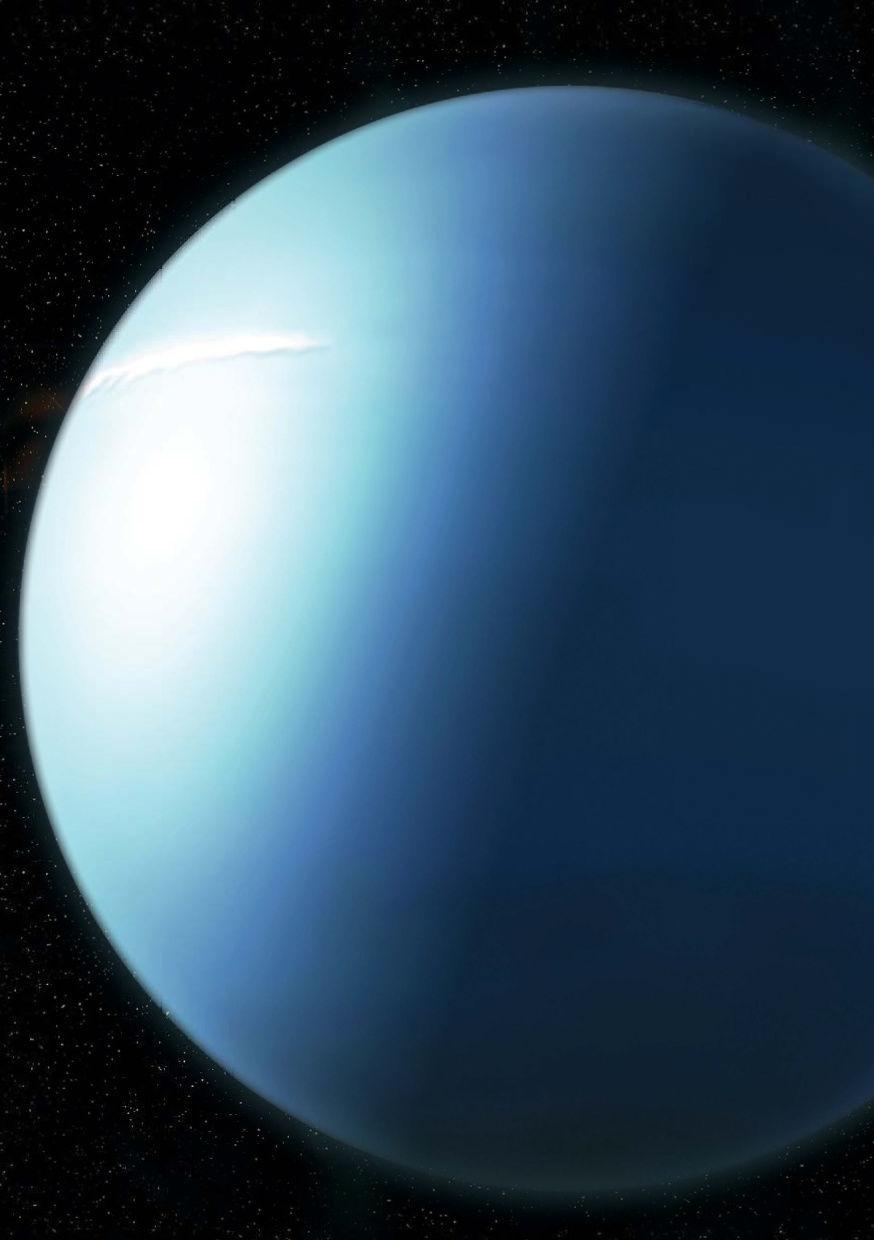
URANUS
The Solar System’s forgotten planet has long been thought of as a dark, cold, characterless world, but the seventh planet from the Sun has its own unique twist and some fascinating features
While William Herschel officially discovered Uranus in 1781, he wasn’t the first to observe it. Others thought it was a star and Herschel himself called it a ‘comet’ before deciding that it was, in fact, a planet – and the first one discovered by telescope. Although Uranus can be seen from Earth with the naked eye, it’s so dim and has such a slow orbit compared to the other known planets that it didn’t register as one. It just looks like a faint pinpoint of greenish or bluish light.
Uranus’s acceptance as a new planet overturned beliefs that had been held for millennia about the size of our Solar System, and kicked off a flurry of planetary discovery. But despite Uranus’s significance, we haven’t spent much time visiting the planet. A flyby by Voyager 2 in 1986 marks the only time we’ve explored it. Because of this, we simply don’t know a great deal about Uranus. Until telescope observations in the past few decades, we thought of it as a rather bland planet: dark, cold, slow and with few interesting features.
Uranus is the third-largest planet by radius and the fourth-largest by mass. It’s about 3 billion kilometres (1.86 billion miles) from the Sun, which means that it receives 0.0025 per cent of the sunlight that the Earth gets.
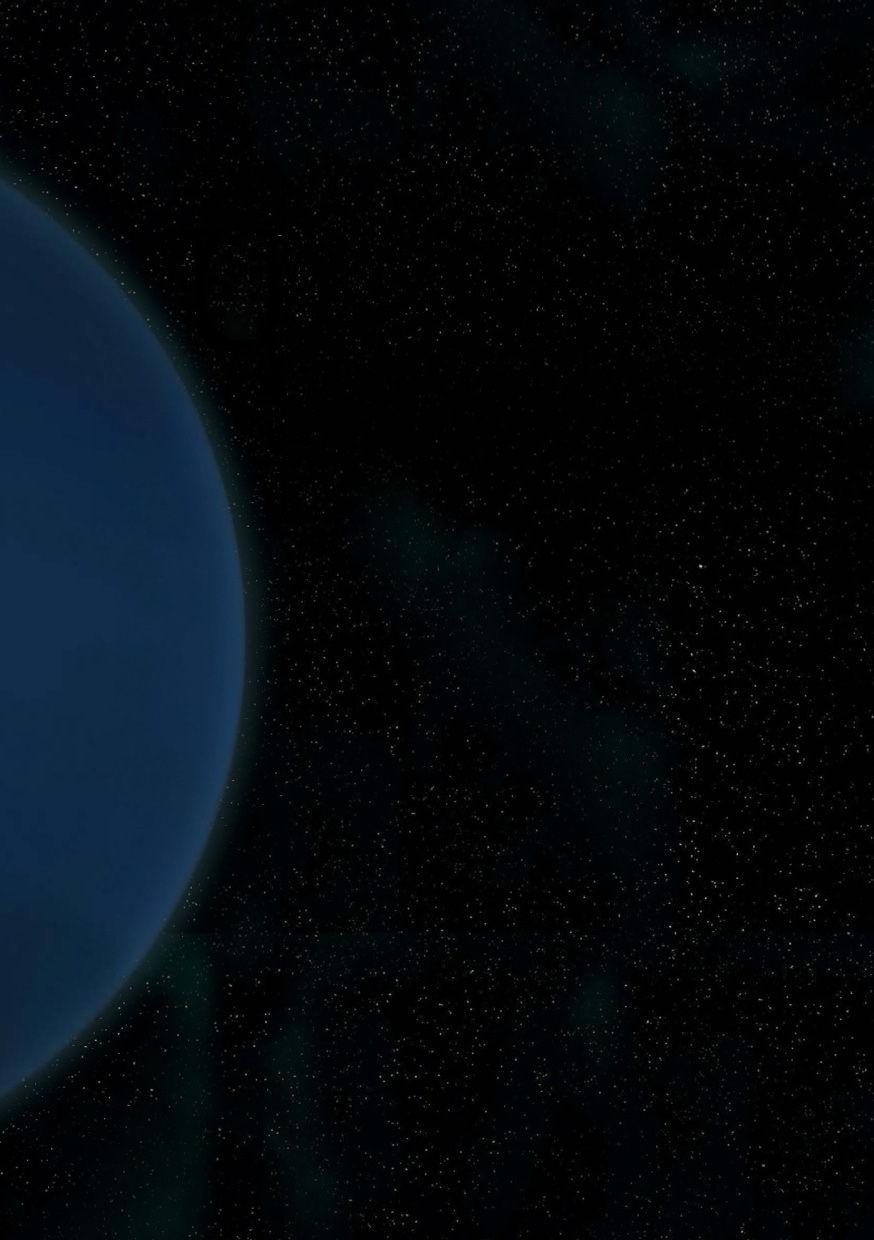
Seasons and tilt
Autumnal equinox
Autumn in the northern hemisphere is spring in the southern hemisphere, with 21 years of alternating days and nights as the equator faces the Sun
Winter solstice
Now it’s the northern hemisphere’s turn to stay dark for 21 years, while the southern hemisphere gets to enjoy sunlight
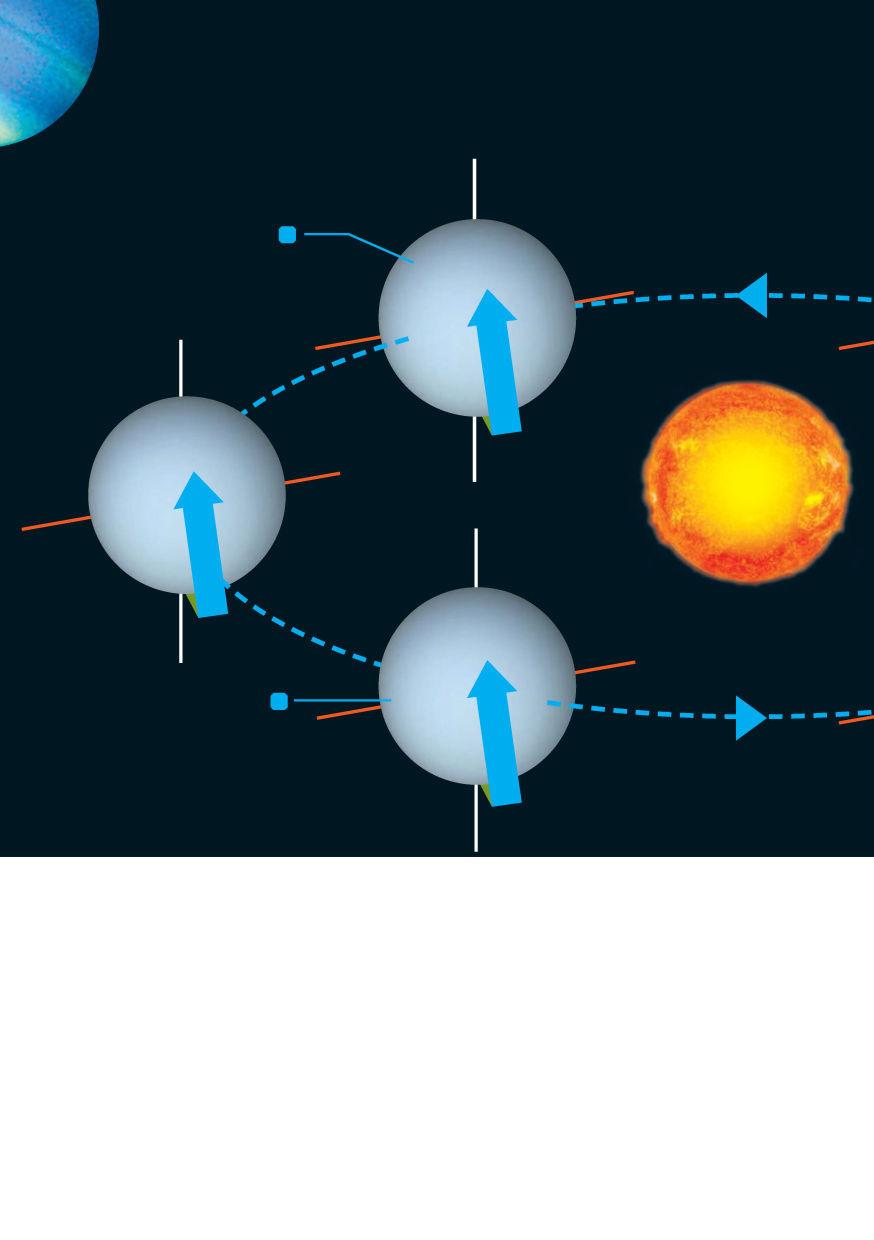
Uranus is a gas giant, along with Jupiter, Saturn and Neptune, with the latter planet sometimes being referred to as its twin. It is the least massive of the four, but still more than 14 times more massive than Earth. Uranus has a diameter four times that of Earth’s. It also has the coldest atmosphere of any other planet in the Solar System, with a mean temperature of approximately -197 °C (-322 °F). Uranus also has a multilayered cloud system, although without the flashy variations of colour seen on planets such as Jupiter and Saturn. However, it does have a lot in common with the other gas giants. It has a magnetosphere that is very similar to Jupiter’s. It has 27 moons, and a system of 13 rings that was discovered not long after Saturn’s ring system. It’s most like Neptune in terms of composition, mostly hydrogen and helium with icy volatiles. Uranus and Neptune are often referred to as the ‘ice giants’.
But Uranus can’t just be lumped in with the other gas giants because the planet has its own unique twist. Literally, as Uranus’s 97.77-degree axial tilt means that it is parallel with the plane of the Solar System – its poles are on either side. While other planets have extreme tilts, none are so perfectly perpendicular to the plane of its orbit. Studies show that Uranus is probably tilted due to
Summer solstice Summer for the northern hemisphere lasts 21 years, while the southern hemisphere stays dark. The day-night cycle occurs only in a narrow band around the equator
Axis and tilt Uranus is tilted 97.77 degrees on its axis, resulting in an unusual seasonal pattern
Vernal equinox Spring in the southern hemisphere and autumn in the north means another 21 years of alternating days and nights

at least two violent, massive collisions one after another, with objects larger than Earth. These impacts likely occurred early in the planet’s life, before its moons formed, and made astronomers rethink how other gas giants formed.
The tilt has impacted just about everything about Uranus. It has extreme seasons and weather fluctuations since each hemisphere experiences either full Sun or deep space. Its magnetosphere is tilted and asymmetric. The ring system is also on its ‘side’, and comes close to rivalling Saturn’s in complexity. The moon system is less massive than any other gas giant’s system. So, in many ways, Uranus is unique.
Compared to Saturn and Jupiter, Uranus and Neptune are very small gas giants. But Uranus is still more than 60 times greater in volume, 14 times greater in mass and four times greater in diameter than Earth

Uranus, as viewed from
Miranda in this artist's impression, has a unique 97.77-degree axial tilt
A unique spin on a planet
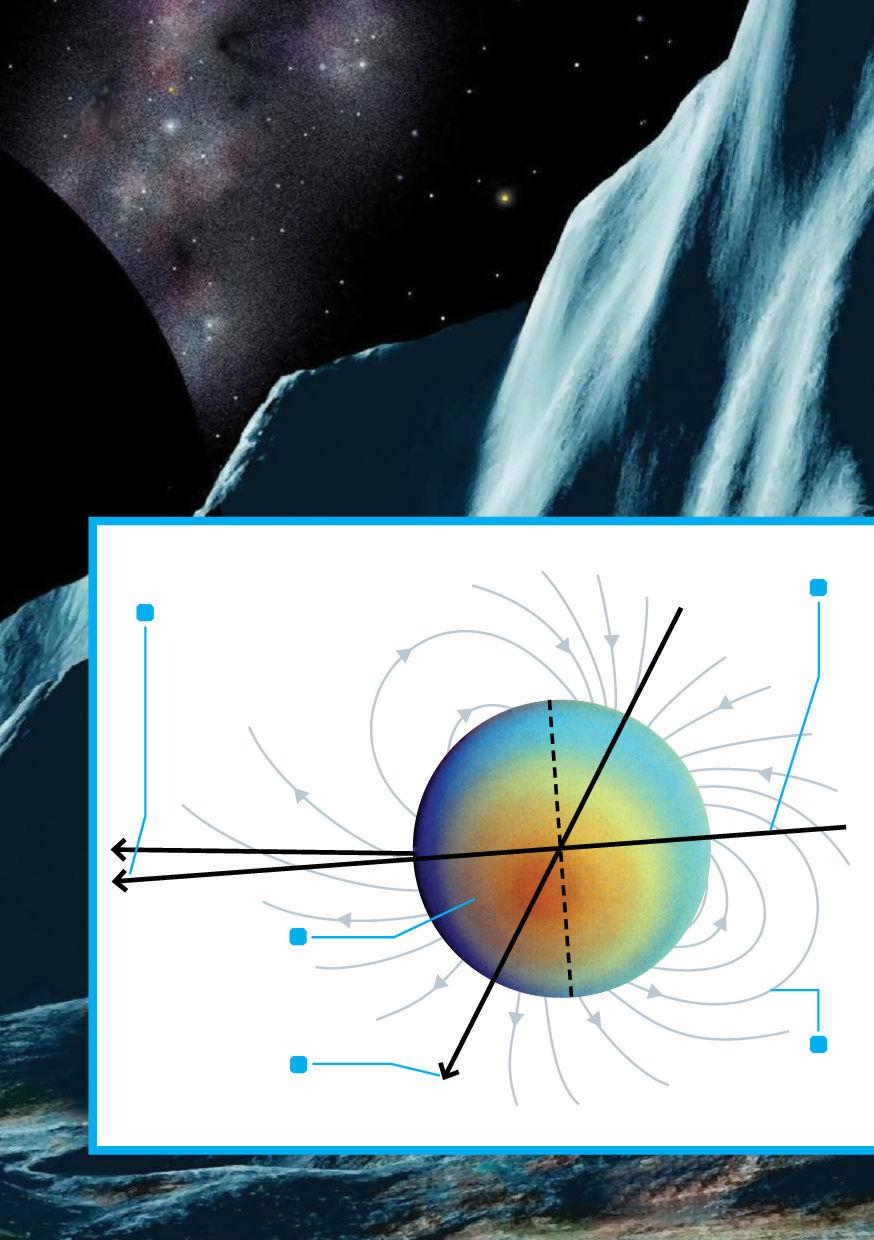
Geographic north pole The huge difference between magnetic north and geographic north may be attributable to a very salty ocean beneath the planet’s surface that is not located at its core
SSpin axis Uranus spins on its side, and has been described as rotating like a beach ball
Dipole field axis The main magnetic field does not pass entirely through the planet, resulting in multiple poles
Magnetic north pole Uranus’s magnetic north pole is a full 59 degrees tilted away from its geographic north pole
N
Magnetic field This varies greatly depending on the area. In the northern hemisphere it might be much stronger than Earth’s; in places in the south, it’s much weaker






